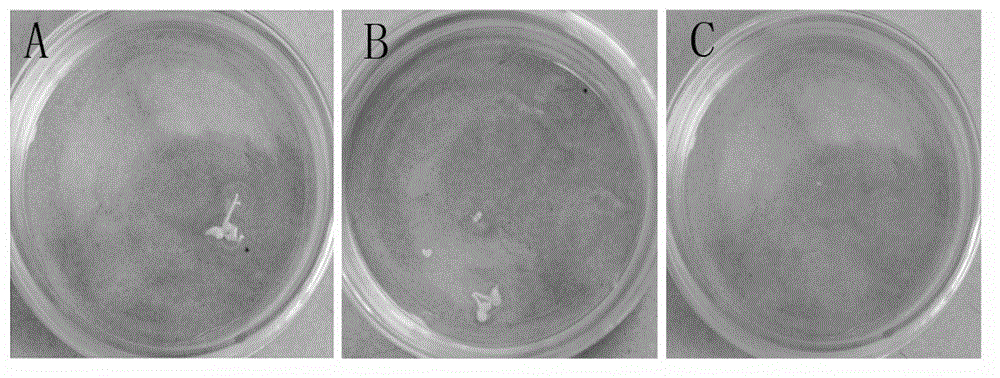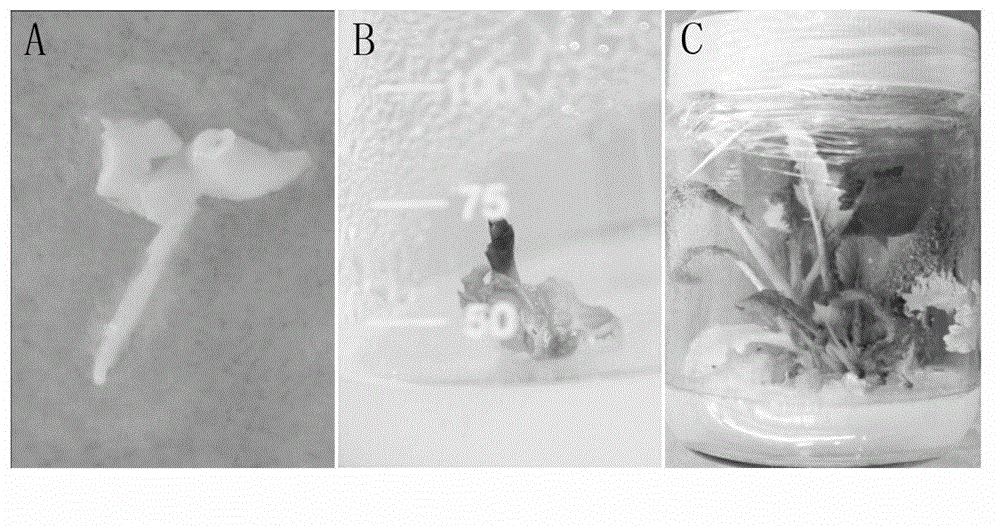Method for improving embryogenesis efficiency and plant regeneration efficiency of stem nodule mustard microspore embryo
A technology for embryogenesis and regeneration efficiency, applied in plant regeneration, botany equipment and methods, horticultural methods, etc., can solve problems such as vacancy of microspore culture technology
- Summary
- Abstract
- Description
- Claims
- Application Information
AI Technical Summary
Problems solved by technology
Method used
Image
Examples
Embodiment 1
[0031] The preparation of embodiment 1 culture medium
[0032] 1. Preparation of mother liquor
[0033] Before the experiment, the culture medium required in the method of the present invention is prepared into a mother liquor and stored in a 4°C freezer. It is divided into a large amount, four kinds of iron salt, trace and organic, and its preparation concentration is respectively 20 times, 20 times, 200 times and 200 times, the specific composition is shown in Table 1.
[0034] Various mother liquor formulas of table 1 microspore culture
[0035]
[0036]
[0037] 2. Preparation of B5-13 medium
[0038] In this operation, it is a 1L medium formula, and the operation is as follows: add 50ml, 50ml, 5ml and Mix 5ml into 600ml distilled water and mix well. Then add 0.1g inositol and 130g sucrose in sequence, stir with a stirrer (domestic GL3250A) until completely dissolved, set the volume to 1000ml, and adjust the pH value to 5.75-5.80 with a pH meter (Mettler FE20K). D...
Embodiment 2
[0045] The selection of embodiment 2 microspore development period
[0046] In this embodiment, take the stem mustard material Yongzai No. 2 (Y04), Qingdao mustard mustard (Y06), Zhongdu mustard (Y08), and Yongzai No. 2╳Qingdao mustard (Y09) (Yongzai used in the present invention Both No. 2 and Qingdao mustard mustard can be bought in the market. Yongzae No. 2╳Qingdao mustard is a variety available in the market for hybridization (F1 generation) of the main inflorescence flower buds, and the anthers of 2mm, 3mm, and 4mm flower buds were respectively taken for 1% Acetate magenta (mix 1 g of magenta, 45 ml of glacial acetic acid and 55 ml of distilled water, boil for 2 hours, filter with gauze after cooling, add 1 drop of 4% iron alum) and observe under a microscope (Olympus, Japan). Within one week of the flowering period, the proportion of flower buds with a length of 2-3mm in the single-core side stage and the double-core stage reached 80%-90%.
Embodiment 3
[0047] The separation of embodiment 3 free microspores and the induced embryo
[0048] (1) Material collection period: The initial flowers appeared as 2-3mm flower buds within one week of flowering on the first day of the first flowering stage (refer to Example 2) for isolation of free microspores.
[0049] (2) Material sterilization method: Since the flowering period of the stem mustard material is more likely to be in the rainy weather, the humidity of the flower buds affects the efficiency of sterilization. In this experiment, 0.1% HgCl 2 Comparing the sterilization time of 8 and 12 minutes, it is found that the contamination rate of materials sterilized for 8 minutes is 85%, and when the time increases to 12 minutes, the contamination rate is 10%. Therefore, the sterilization time in rainy weather can be increased to 12 minutes as the best.
[0050] (3) Cleaning: Place the flower buds of the material in step (2) into sterile water and wash three times, 3 minutes each time...
PUM
 Login to View More
Login to View More Abstract
Description
Claims
Application Information
 Login to View More
Login to View More - R&D
- Intellectual Property
- Life Sciences
- Materials
- Tech Scout
- Unparalleled Data Quality
- Higher Quality Content
- 60% Fewer Hallucinations
Browse by: Latest US Patents, China's latest patents, Technical Efficacy Thesaurus, Application Domain, Technology Topic, Popular Technical Reports.
© 2025 PatSnap. All rights reserved.Legal|Privacy policy|Modern Slavery Act Transparency Statement|Sitemap|About US| Contact US: help@patsnap.com



